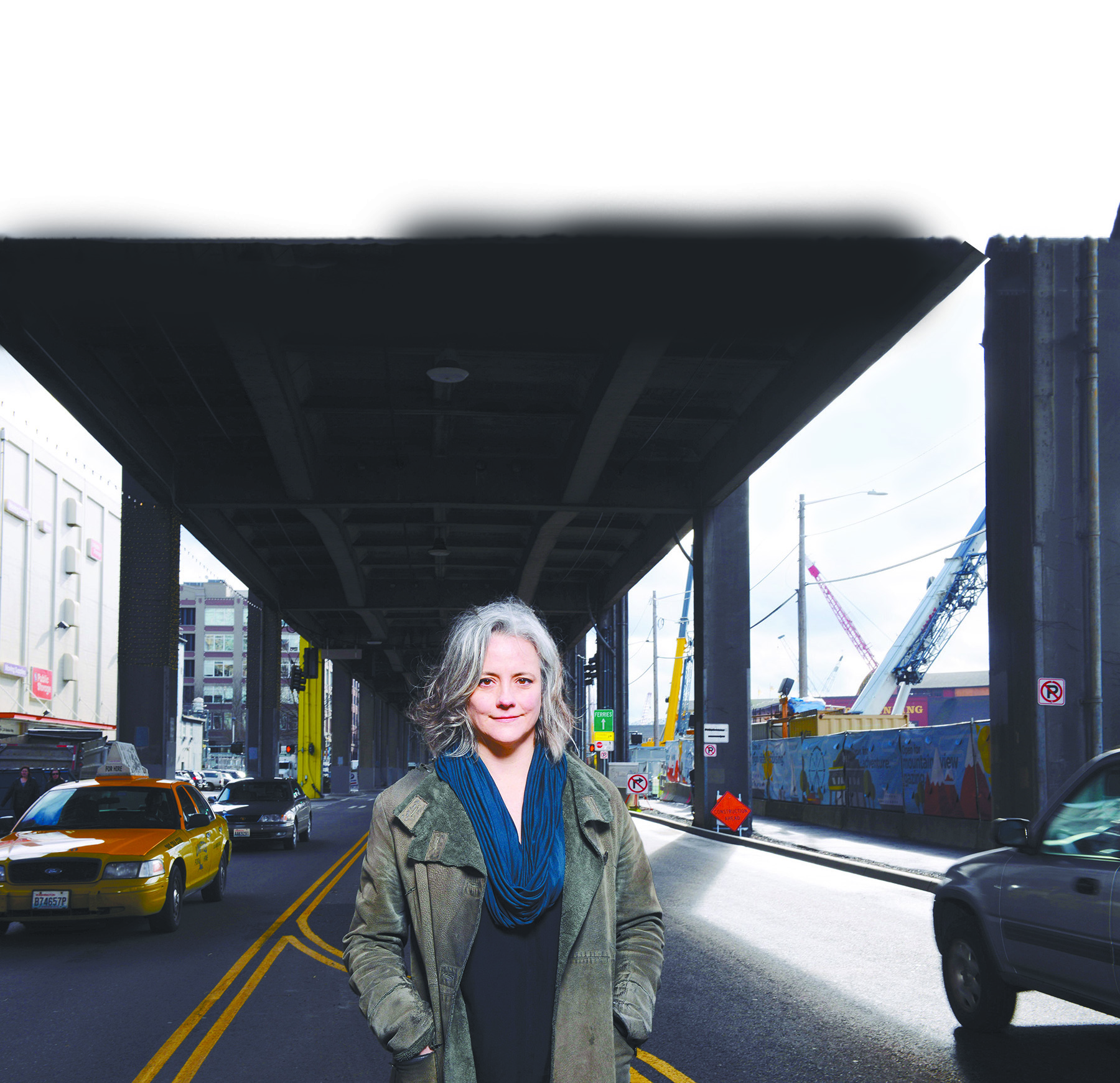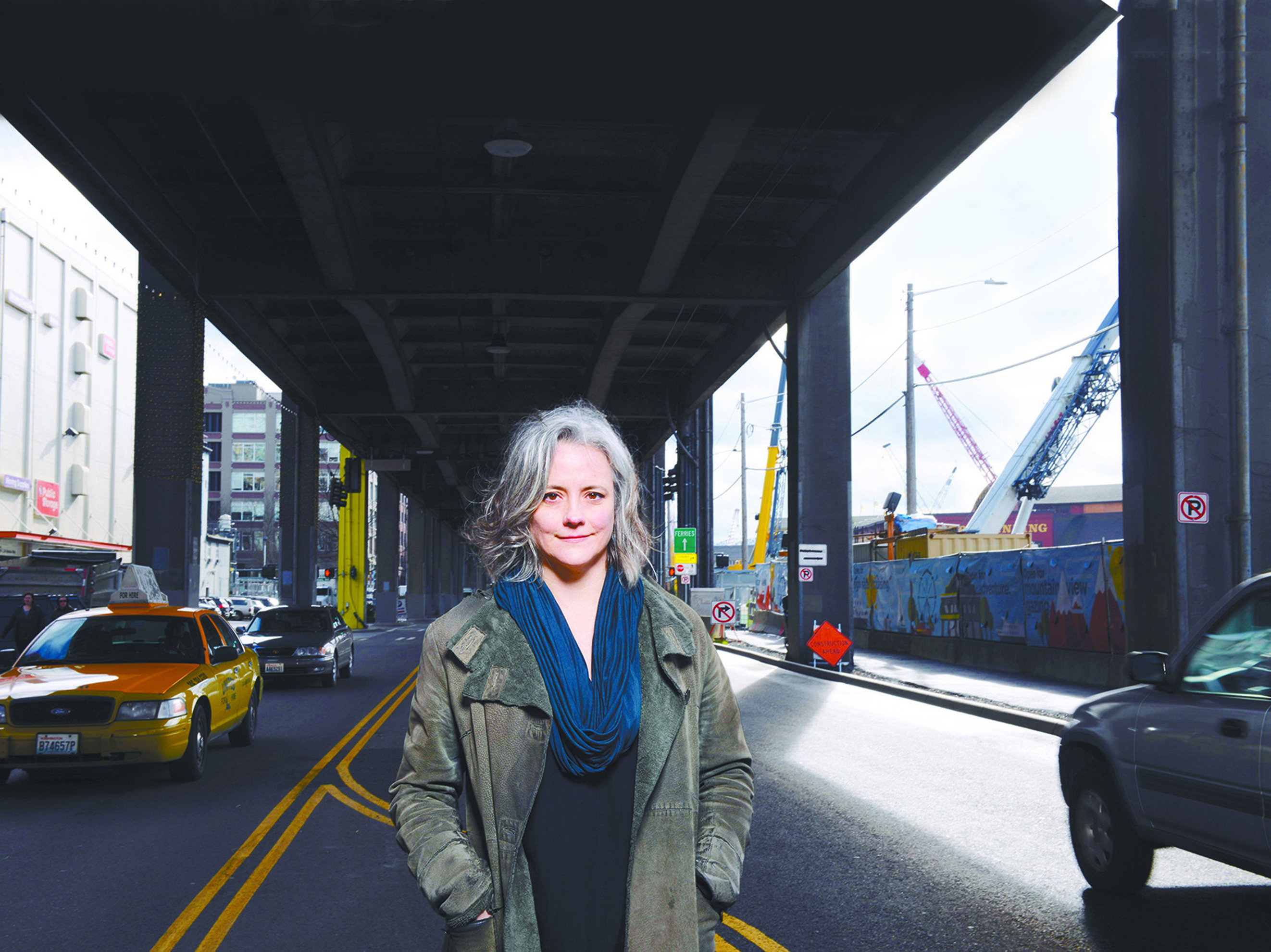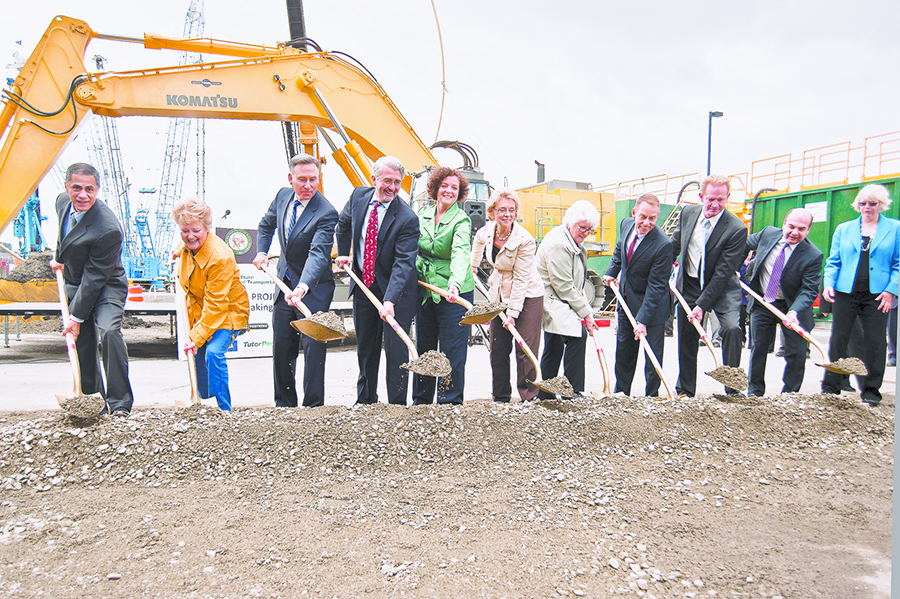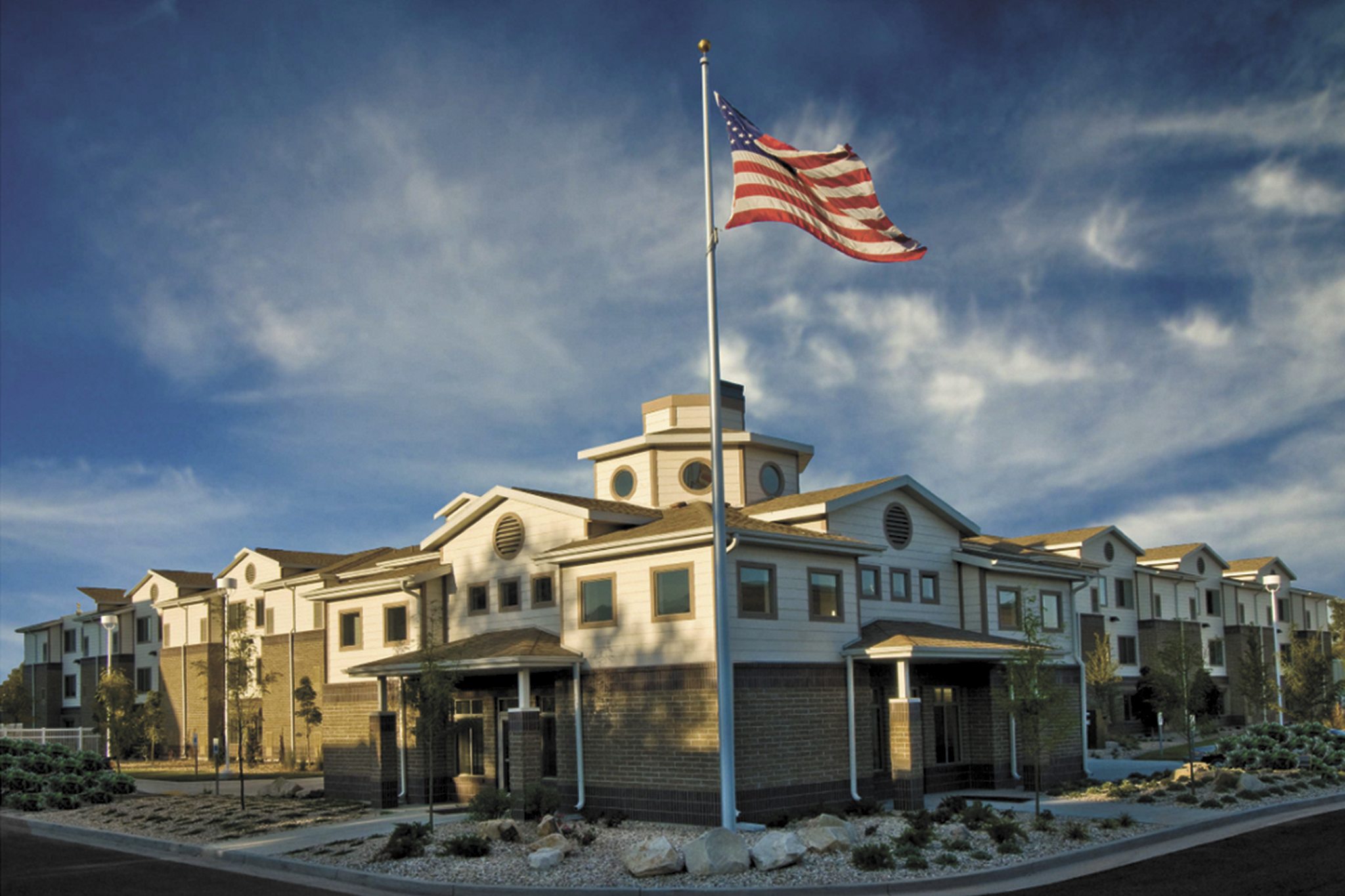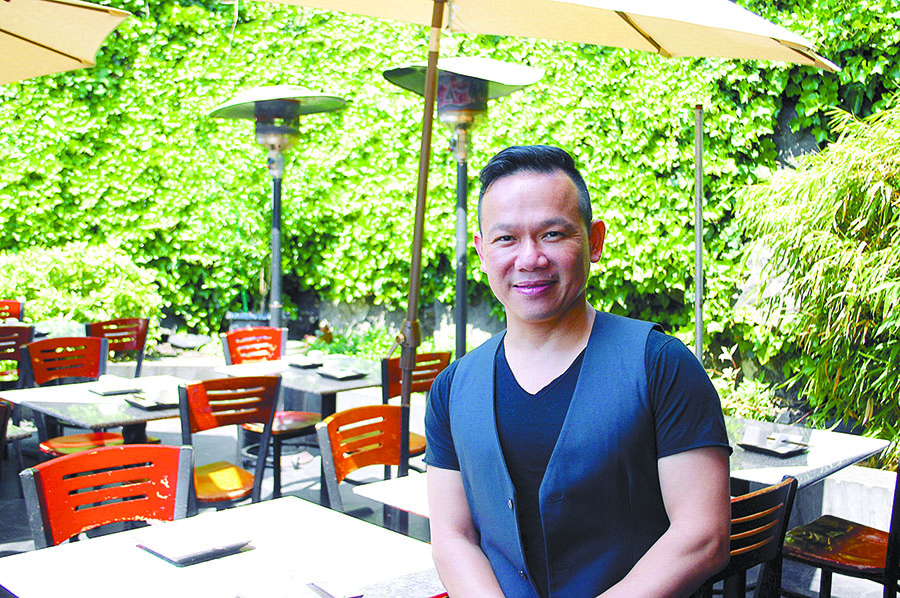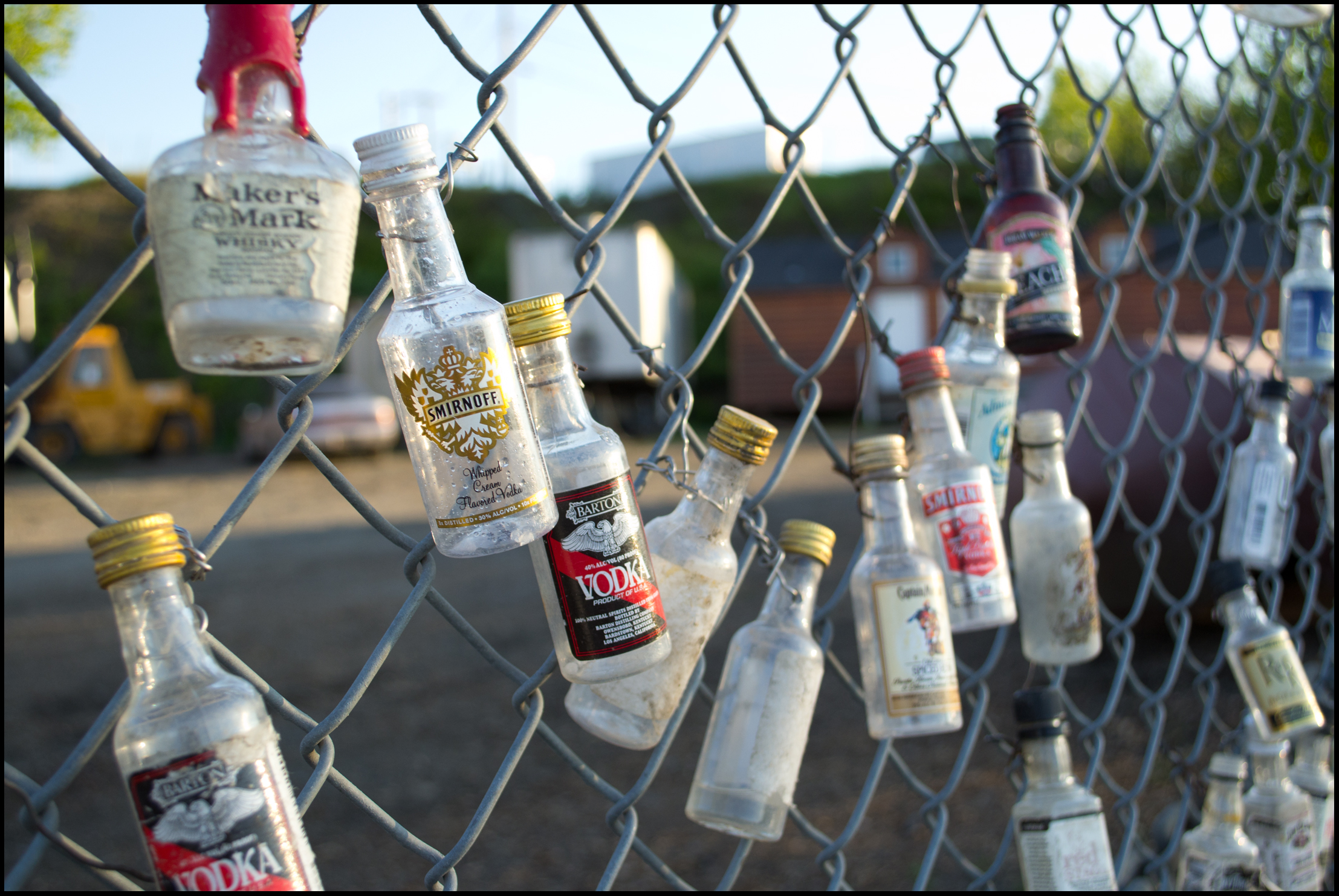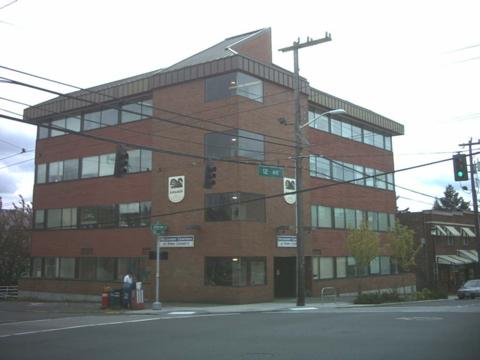Bertha, before the troubles. Courtesy of WSDOT
As the late-January morning fog gingerly flees, revealing a postcard glimpse of Elliott Bay’s churning blue waters, Cary Moon prepares to dig into a steaming bowl of lentil soup at the Sound View Cafe in Pike Place Market. Engineer and landscape designer by trade, Moon is an urban activist at heart. More than a decade ago, she founded the People’s Waterfront Coalition, a tunnel-averse group committed to seeing the Alaskan Way Viaduct, badly weakened in the Feb. 28, 2001 Nisqually earthquake, ripped down and replaced with a waterfront park and a reconfigured boulevard with ample transit services.
Now, as the most expensive transportation project in Washington history is the subject of both jokes and groans, there’s a growing sense that those earlier Viaduct replacement plans might not seem as impractical or farfetched as many considered them years ago.
As is her way, the 51-year-old Moon, whose most striking feature is a shimmering mane of silvery hair, gets right to the point. The soup will have to wait. “The surface-street option has never been on the ballot,” she begins. “It was too hard to explain. It was politics and money that gave us the tunnel. The downtown business interests, the Chamber of Commerce, Boeing, the unions, they all wanted a highway, period. Nothing was going to stop them. Then to name it Bertha, our only woman mayor—how appalling and disrespectful.”
Moon, the Pennsylvania-born daughter of an engineer, is highly regarded among transportation planners and those Seattle progressives opposed to plans to build a waterfront highway—whether elevated, constructed at ground level, or submerged—to replace the Viaduct. No one has been more relentless and persistent than Moon, who made Seattle her home in 1997.
“She’s brilliant,” says Ben Schiendelman, co-founder of Seattle Transit Blog. “She’s been right on this street option, and it’s nice to see her vindicated.”
Moon, whose People’s Coalition was a force to reckon with when the raging tunnel debate reached its zenith, works quietly now, usually behind the scenes. City Council contenders have in recent weeks begun to seek her counsel, meeting with her in the back corners of coffee shops, mindful that the ongoing tunnel drama (and resulting trauma) may surface in candidate forums and debates in the 2015 election.
“I think there’s a strong possibility this will be a political issue this year,” speculates Peter Steinbrueck, a former Seattle councilmember who waged an unsuccessful bid for mayor in 2013. “Not exploring further the street option, I believe, was a lost opportunity.”
No one can say at this point whether Bertha’s failures, if they continue, could result in the deep-sixing of the project in favor of a waterfront street. But the city says it is prepared to resort to a de facto surface option if the Viaduct must come down before the tunnel opens. As Seattle Transportation Department director Scott Kubly told Seattle Weekly, “We have plans what to do if we need to immediately close the Viaduct, which would call for a huge increase in transit in this area.” Still, the price tag for turning tail and abandoning ship is anyone’s guess.
A mother of two teenagers and married to architect Mark Reddington, the lead designer of Benaroya Hall, Moon says her motives are simple. “I love cities, and the waterfront is precious land that I want to reclaim for the public. It has become clear now we can transform the waterfront without a tunnel.”
“She may well yet succeed,” says Denis Hayes, president of the Bullitt Foundation and a key organizer of the nation’s first Earth Day, in 1970. “The politics may well line up against the tunnel.”
“Cary Moon has created the culture that made it possible to look and see if there wasn’t another way of doing this project,” says former King County Executive Ron Sims, an early booster of what Moon has long envisioned, a transit-rich street in lieu of a tunnel.
Or as ex-Mayor Mike McGinn, the city’s most prolific tunnel detractor, put it: “Cary deserves all the credit for just saying that when you take a closer look and study all the facts, there is a better way.”
She is polished, professional, and fact-driven, says Transportation Choices Coalition director Rob Johnson. “And,” he adds, “she is always very good at disagreeing with people without being disagreeable.”
Says City Planning Director Marshall Foster: “Her commitment is deep. Cary really started the discussion about a surface street, and she’s kept that discussion going.”
Moon, a political comet, led the so-called “Hell and Hell No!” campaign in 2007, when, in an advisory vote taken March 14, Seattle’s electorate expressed widespread opposition (55 percent) to a new elevated highway. Voters were even more critical of the six-lane cut-and-cover tunnel pushed by former Mayor Greg Nickels, with nearly 70 percent opposed.
Recalls Sightline executive director Alan Durning: “At an election-night gathering, they asked Nickels who was the night’s biggest winner. He nodded to Cary Moon.”
“It was fun then,” muses Moon. “We had the momentum.”
“Cary Moon has created the culture that made it possible to look and see if there wasn’t another way of doing this project.”
Moon’s crusade crested that breezy evening in March 2007. A string of defeats would follow, culminating in the final days of December 2008—the most critical month of the project’s contentious 14-year history—when vigorous pro-tunnel pressure was exerted on then-Gov. Chris Gregoire by business, aerospace, and organized labor interests.
On Jan. 13, 2009 came “the Kumbaya moment,” as Moon and others have come to call it: Gregoire, long a vocal advocate of a bigger and wider elevated freeway, stood smiling with Nickels and Sims at the World Trade Center in Seattle.
That morning, Gregoire, who had won re-election two months before, again beating Republican Dino Rossi, proceeded to reveal her choice to replace the aging Viaduct: a four-lane, two-mile tube running beneath Seattle’s waterfront—at 54 feet in diameter the widest deep-bore tunnel ever attempted. Its cost was estimated at $3.1 billion, which included demolition of the Viaduct. Construction would begin in 2011 and the tunnel would open in 2015. (Note: The overall cost of the project was estimated at $4.25 billion, which included the actual tunnel, utility realignments, a seawall upgrade, and street and transit improvements.)
On Jan. 30, 2009, then-state Sen. Ed Murray introduced SB 5798, requiring the state to take the necessary steps to replace the Viaduct with the deep-bore tunnel. The bill set funding limits at $2.4 billion in state funds, generated largely through an increase in gas taxes, and $400 million from tolling. (Murray declined to be interviewed for this story.)
“We couldn’t believe she would turn around and do this. None of us believed Gregoire would build that tunnel for $2.8 billion,” recounts Seattle City Councilmember Mike O’Brien. In 2008, O’Brien was a Sierra Club director and one of the 29 members of the Stakeholders Advisory Committee, created to advise city, county, and state transportation leaders. The Committee comprised members of neighborhood and advocacy groups (Moon represented the People’s Waterfront Coalition), as well as representatives of business and labor. The state legislature set December 2008 as the deadline for these groups to recommend a Viaduct replacement solution.
“It should be called Gregoire’s Bertha, for she did the bidding for business and labor. She gave us the tunnel,” says David Bricklin, a prominent Seattle environmental attorney.
“We were defeated by Gregoire,” says Moon. “I went to that event that day [the World Trade Center press conference] and I asked, ‘What will you do if this doesn’t come together, if the technology doesn’t work out, or if the funding doesn’t come through?’ And David Dye [then-deputy secretary at the Washington State Department of Transportation] said, ‘There is no Plan B.’ ” (Gregoire declined to be interviewed for this story; former mayor Nickels also did not return numerous calls seeking comment.)
Despite’s Gregoire’s tunnel-ahoy declaration in January 2009, the battle went on, until finally on Aug. 16, 2011, Seattle voters, weary of the prolonged debate, voted by a nearly 60 percent margin to go ahead with the tunnel. Moon says the People’s Waterfront Coalition disbanded soon afterward.
“That was pretty much it for me, and I just started working on the waterfront with the city,” says Moon, who was a member of the design-oversight committee that last September unfurled plans to redevelop 22 blocks along the downtown waterfront.
The June 2012 groundbreaking: The first shovelful is the easiest. Courtesy of WSDOT
Today, Seattle’s megaproject is reeling. In December 2014, the deep-bore tunnel was the runaway winner for Streetsblog USA’s “Highway Boondoggle of the Year” award. The same month, Engineering News-Record, an influential weekly magazine that provides news, analysis, and opinion for the construction industry worldwide, listed Seattle’s tunneling endeavor, now two years behind schedule, as one of “the year’s [2014] worst projects.”
Since Bertha pulled up lame 14 months ago, her seals and central bearing broken, the world’s largest tunnel-boring machine has barely budged an inch. Just 1,000 feet of the nearly two-mile subterranean highway has been completed. A 120-foot-deep rescue pit is nearly completed, which means that at long last workers can extract the cutter head of the stranded $80 million monstrosity, fix it above ground, lower it back down, and pray to the almighty tunnel gods that it works when they fire Bertha up, perhaps in March or April.
The repair work has destabilized the Viaduct, a 62-year-old structure built on landfill with 24,000 cubic yards of concrete and 10,000 tons of steel—and in soil, no less, with a risk of liquefying in an earthquake. Some parts of one of the city’s historic neighborhoods, Pioneer Square, have sunk by an inch or more, while cost overruns are becoming an increasingly serious concern. At the same time, nobody is certain exactly what caused the machine to break down in the first place; whether it can be fixed; or, if it is, whether it will break again. The new tentative ribbon-cutting date for the tunnel is September 2017, nearly a year and a half late.
Meanwhile, distrust festers between the project’s overseer, WSDOT, and the contractor, Seattle Tunnel Partners. So frayed are relations between the state’s Highway 99 project and the city of Seattle that the City Council on January 12 signed off on a $155,000 independent engineering study into whether tunnel work is making the Viaduct unsafe to drive on. SDOT’s Kubly told Seattle Weekly that the CH2M Hill report should be completed next month.
As of press time, Seattle Tunnel Partners has completed a cradle at the bottom of the 120-foot pit. But now Bertha will have to grind her way about 20 feet through a concrete wall to reach it and enable crews to remove the cutting head, 57 feet in diameter. At that point, a massive crane will hoist it to the surface for repairs. There is concern, though, that Bertha won’t be able to drill that far.
As if to mock the project’s repeated setbacks, late last month two GOP state senators, Doug Ericksen of Ferndale and Mike Baumgartner of Spokane, introduced a bill to order WSDOT to stop the project dead in its tracks and devise a plan to fill in the incomplete tunnel. Senate Transportation Committee chairman Curtis Wilson (R-Yakima), though, quickly pulled the plug on the legislation, saying the bill would not even get a hearing, never mind pass out of committee.
“It’s coming down in 2012,” a defiant Gregoire declared at a press conference in Olympia on Jan. 3, 2008. “That’s the time line. I’m not going to fudge on it. And if we don’t have some alternative by then, boy are we going to have a mess on our hands, because it’s coming down.” Asked whether she could, as governor, unilaterally tear down a highway that carries more than 100,000 vehicles a day through the state’s largest city, Gregoire said, ‘Yeah, watch me.’ ”
Later in 2008, as replacement alternatives boiled down to three—a new Viaduct, a tunnel, or a surface street—the city hired Nelson/Nygaard Consulting Associates to explore the feasibility of pursuing the street/transit option.
In essence, the firm was tasked to flesh out the details of a broad-brush surface-street plan outlined by Moon and other land-use professionals who’d enlisted in the People’s Waterfront Coalition, including Grant Cogswell, co-author of the 1997 Seattle Monorail Initiative; Julie Parrett, a UW land architecture instructor; and Ralph Cipriani, a former manager of the Metropolitan Transportation Plan for the Puget Sound Regional Council. (“We weren’t a bunch of amateurs,” notes Moon.)
Their surface-street concept was similar to the Urban Mobility Plan led by the SDOT in late 2007, which Nelson/Nygaard helped prepare and rolled into their report, concluded in late December 2008. Tim Payne, a principal with Nelson/Nygaard, today tells Seattle Weekly that the so-called “I-5/surface/transit plan” could still work.
In an interview earlier this month, Payne said, “Nothing has happened since to give me a thought that our conclusions were not correct.” He went on: “I don’t know what became of our report, but I can see why people are still asking what-if questions.” It is not known whether Gregoire saw this report.
On December 11, 2008, the city, state, and county announced two finalists for Viaduct replacement. The tunnel did not make the cut. WSDOT, for one, concluded that the deep-bore tunnel was too costly. Before the closing meeting of the stakeholders’ group a week later, WSDOT’s Dye said, “It is out of reach in the current state of affairs to make it happen.” He added, “It would be disingenuous of me to sit here representing the state to say, ‘Geez, you know, let’s go build a deep-bore tunnel.’ ”
The two options left standing were a new $3.5 billion elevated structure and a surface/transit hybrid that would direct most traffic over a pair of north- and southbound streets along the waterfront. Alaskan Way would become a one-way southbound street with three lanes and a bike lane. Western Avenue would become a one-way northbound street with three lanes and a bike lane. The estimated cost of the street plan came in at $2.2 billion, but with construction, traffic mitigation, and related projects, the cost would be $3.3 billion.
On its website that same month, December 2008, WSDOT wrote: “This [surface-street] alternative is put forward for further consideration as it offers a lower-cost SR-99 that maintains the economic vitality of the city and region while reconnecting the city’s historic waterfront with downtown.”
But the Great Recession was at full tilt by then, and Gregoire was concerned with costs. “Who’s going to pay?” she asked. “We have $2.8 billion, period.”
Outgoing governor Christine Gregoire hands Bertha off to newly elected Jay Inslee. Courtesy of WSDOT
Six days later, on December 18, 2008, the snow arrived in Seattle. Six inches fell, a prelude to a week-long storm that would cripple the city. Tardy removal of the white stuff would go a long way toward ringing the death knell on Mayor Nickels’ re-election bid the following year. On this snowy evening, only about half the stakeholders arrived at a SDOT office inside the Municipal Tower. Though clearly divided on a Viaduct replacement, most of them made it clear that the tunnel option needed further evaluation and should be subjected to the same environmental review as the elevated and street alternatives.
At the meeting, according to Moon, she said, “We need to move forward with something we can afford now, but leave the door open [for the tunnel].” Last week, Moon clarified: “The compromise we were making was to move forward with the surface/transit option, and if it didn’t work out and provide enough bypass capacity, then go ahead with the tunnel.”
Tayloe Washburn, then a member of the Seattle Metropolitan Chamber of Commerce, spoke out vigorously for the tunnel that December evening. “We can do this and we must,” he recently recalled saying. “If we start from a few sensible building blocks and a few sensible principles, we can build a bored tunnel.” Last week, Washburn, now CEO of Northeastern University in Seattle, told the Weekly, “We had very diverse opinions, but the main reason the tunnel was chosen is that it would enable better truck and cargo flow.”
John Odland, a stakeholder representing the Manufacturing Industrial Council, agreed, then and now. As he explained in a recent interview, “I never believed the surface street-option would have given us the mobility we needed.”
Also pushing hard for the tunnel was the Discovery Institute’s Cascadia Center, a nonprofit think tank that explores transportation issues in the region. “We told [those at the stakeholders’ meeting] that our research had found that technologies had dramatically increased that would allow the Viaduct to stay up during construction of a tunnel,” the Center’s policy director Bruce Agnew recalled.
This proved a significant tipping point, particularly among business and maritime interests who feared major disruption if the Viaduct would have to come down before any kind of waterfront highway, including the tunnel, could be built.
“Bruce was a very good salesman,” recalled Moon. “He brought in [to stakeholder meetings] the world’s biggest tunneling experts, who were very convincing in making that case.”
The experts apparently impressed the MIC, which in mid-December 2008 dispatched a letter to Gregoire that read in part, “It appears the deep-bore tunnel might provide adequate through-capacity both during construction and upon completion, because of the potential to preserve the existing SR 99/I-5 corridor while the tunnel is being built.”
“We couldn’t believe she would turn around and do this. None of us believed Gregoire would build that tunnel for $2.8 billion.”
Still, Councilmember
O’Brien, a stakeholder at the time, stressed that “there was never a group recommendation that came forward” following months of discussion by the advisory committee. “The closest thing to a recommendation was the letter.” O’Brien is referring to a December 18 letter, revised several times, that was sent to Gov. Gregoire, Nickels, and Sims. It stated: “After considerable analysis, input, and consultation with our constituencies, we recommend & conclude the following: Move forward with an Alaskan Way Viaduct Replacement Plan that includes improvements to I-5, transit, surface streets, and potential for construction of a deep-bore tunnel. These improvements should move forward as soon as possible to mitigate removal of the Viaduct.”
The letter was signed by seven members of the advisory committee: Mary McCumber of Futurewise; Rob Sexton of the Downtown Seattle Association; David Freiboth, executive director of the King County Labor Council; Rob Johnson of the Transportation Choices Coalition; Washburn of the Seattle Chamber; O’Brien of the Sierra Club; and Moon.
In retrospect, says Moon, “We should have been firmer in support of the surface street. They [the governor’s office] took this letter as a sign of capitulation, that somehow there was unanimous agreement [for a tunnel].”
Freiboth sharply disagrees. “No, that was not my interpretation of the letter. What we were saying, and it was a consensus [among the 29 stakeholders], was that if the tunnel was not feasible, then, OK, go ahead with the surface street. Everyone agreed we’d had enough discussion. It was time [for the governor] to make a decision.”
The longtime labor leader adds, “For me, the a-ha moment came when we were given a presentation by Gehl [Architects], out of Copenhagen, who said that when you take down the Viaduct and dump 40,000 cars on the streets, you are going to have a very adverse and disruptive impact on mobility. I know that [finding] came much to the consternation of O’Brien and Cary Moon.”
On December 23, 2008, Gregoire conducted a conference call with the state’s top three transportation officials. Decision time was fast approaching. On the phone was Grace Crunican, then director of Seattle Department of Transportation; King County Transportation director Harold Taniguchi; and WSDOT’s David Dye. “We were all trying to reach closure and we’d worked up two options, the tunnel and the surface street,” Crunican, now general manager of Bay Area Rapid Transit (BART), told the Weekly in a recent phone interview from San Francisco.
“The governor asked me if I thought the surface option would work, and I said, ‘Yes, it would work to my satisfaction,’ ” Crunican recalled. “I don’t recall her being that enamored with the surface option.”
Taniguchi, long a supporter of some version of a surface-street, transit-laden alternative, corroborated Crunican’s account of the conference call. “I also said to her [Gregoire] that I was comfortable with the surface option, and I know [Ron] Sims was too.”
Washburn concedes that Boeing and Microsoft, in particular, pressed their case for the tunnel with Gov. Gregoire. “Certainly, they had an interest for obvious reasons, being able to move their product and their people.’ But Washburn stressed that any pressure that they, or the Chamber, exerted was no more aggressive than anyone else’s.
“No,” counters Moon, “their voice was always louder than ours.”
“Put yourself in her shoes,” Washburn continues, referring to the ex-governor. “We [the stakeholders] were simply an advisory group. Once we were done, we moved the ball to the political court and she was just trying to identify a viable path.”
On why Gregoire chose the tunnel, labor chief Freiboth says, “The discussion had to end. We were being held up as a community that could not make a decision. You know, the Seattle Process.” He points to the long and anguished debate over whether to expand Seattle’s monorail and how repeated votes on that ill-fated endeavor prompted national headlines that Emerald City residents were veritable Hamlets when it came to making up their mind. “But I think what it finally came down to was she felt she could make it fit in the budget.”
Despite the troubles, Washburn remains a tunnel enthusiast. “Like most projects, stuff comes up along the way. But my views have not changed.”
Nor has City Councilmember Tim Burgess had second thoughts. “The opponents of this project will grasp at any hiccup that arises and will continue to do so from now until the ribbon is cut,” he says.
But like many others, Moon isn’t so sure any tunnel-christening ribbons will be cut. “I don’t think our politicians realize what a disaster this is,” Moon says quietly earlier this month over a cup of green tea at a Lower Queen Anne cafe. “After 2009 [when Gregoire made the decision to build the tunnel], I thought it was a lost cause. Now, who knows? Maybe not.”
Nonetheless, Moon has moved on. She says she’d like to start another urban advocacy group, and that she has begun to feel out the possibility with others. “I want to try and see if we can’t be a middle-income community, where we have affordable housing and open spaces, and we keep industrial and manufacturing jobs in Seattle, so we don’t become another San Francisco.”
She confides then, “You know, I sort of liked the Viaduct, until the earthquake. I sort of thought it was the last bit of grittiness in Seattle.”
As to the future, Moon says, “We need another plan if we have to close the Viaduct for safety reasons. Instead of arguing, let’s find a way to make a surface street work.”
